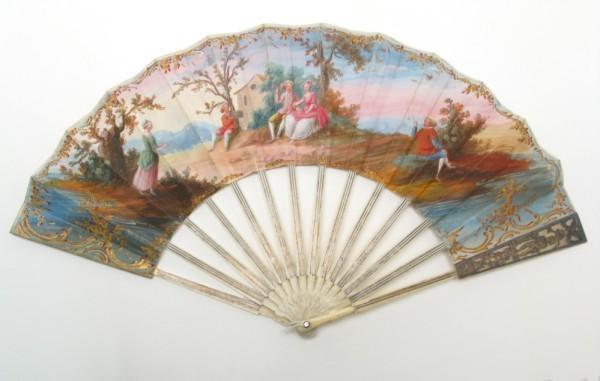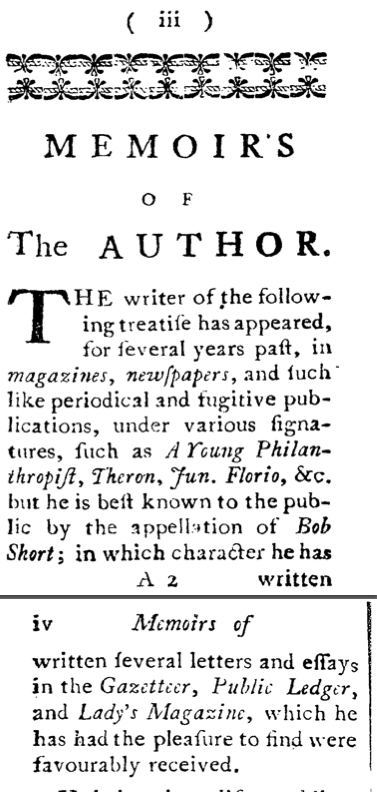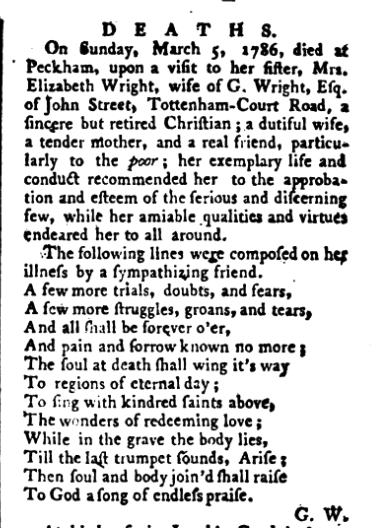Countless are the times I have looked up from reading the Lady’s Magazine to moan in frustration: ‘I can’t stand this man!’
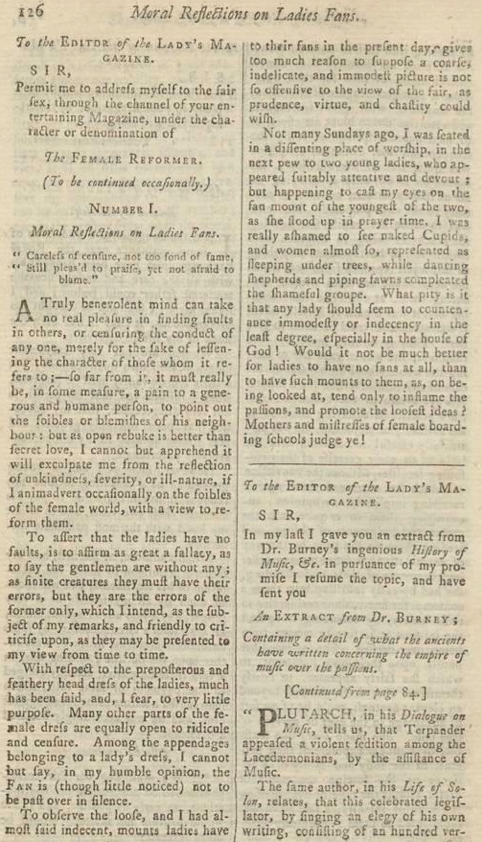
LM VII (Mar 1776): 126. Image © Adam Matthew Digital / British l Library. Not to be reproduced without permission.
I’m speaking of Bob Short, Junior, author of the magazine’s serial ‘The Female Reformer’ which appeared periodically from March 1776 through the mid-1780s. From the outset, Bob Short declares he will ‘animadvert occasionally on the foibles of the female world, with a view to reform them’ (LM VII [March 1776]: 126). This first number sees him criticizing initially the ‘preposterous and feathery head dress of the ladies’ whilst noting that there are ‘many other parts of the female dress [. . .] equally open to ridicule and censure’ before moving onto the fan as the target of his ‘reforming’ remarks.
Yes, you read that right: the fan. No, it didn’t mean something else back then. Apparently Short’s problem with ladies’ fans was with the mounts – ‘the loose, and I had almost said indecent, mounts ladies have to their fans in the present day’ – mounts that make him believe ‘a coarse, indelicate, and immodest picture is not so offensive to the view of the fair, as prudence, virtue, and chastity could wish’. Indeed, these indelicate fan mounts appear even in places of worship where he saw a young woman who ‘appeared suitably attentive and devout’ until he saw ‘naked cupids, and women almost so, represented as sleeping under trees, while dancing shepherds and piping fawns completed the shameful groupe.’ Such pictures, Short declared, ‘on being looked at, tend only to inflame the passions, and promote the loosest ideas’ (LM VII [March 1776]: 126).

LM VIII (August 1777): 422. Image © Adam Matthew Digital / British l Library. Not to be reproduced without permission.
‘The Female Reformer’ column generally contained similar opinions. For example, after spending several numbers criticizing female dress, he turns to female conversation. Obviously, this didn’t fare much better, and is described as being described as ‘trifling, unimportant, and insignificant!’ (LM VIII [August 1777]: 422). Occasionally he would reveal intimate details, such as in his December 1777 column, in which he described the recent loss of a child called Eliza, who had just begun to speak. And although my instincts told me that such remarks were fact rather than inventions for didactic purposes, they weren’t particularly useful in terms of finding out more about the man behind the serial.
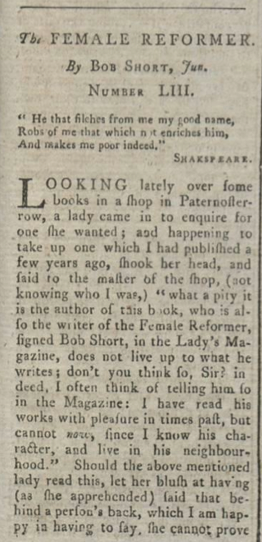
LM XVIII (December 1784): 651. Image © Adam Matthew Digital / British l Library. Not to be reproduced without permission
And so I carried on reading and occasionally rolling my eyes at Short’s remarks without looking into it further until recently. An uncharacteristically personal column by Short was followed by a silence – no further contributions to the magazine appeared – and this perplexing silence piqued my curiosity. Short complains in December 1784 about an incident that occurred at a bookseller’s shop in Paternoster-row (the location of the Robinson’s business and, of course, many other printing and publishing firms in the eighteenth century). Short is clearly incensed by the incident in which a lady picks up a book he published some years ago and ‘said to the master of the shop (not knowing who I was,) “what a pity is it the author of this book, who is also the author of the Female Reformer, signed Bob Short, in the Lady’s Magazine, does not live up to what he writes; don’t you think so, Sir? Indeed, I often think of telling him so in the Magazine: I have read his works with pleasure in times past, but cannot now, since I know his character, and live in his neighbourhood.” Should the above mentioned lady read this, let her blush at having (as she apprehended) said that behind a person’s back, which I am happy in having to say, she cannot prove before his face’ (LM XV [December 1784]: 651). After this, Short offers no further contributions.
There is mention of him in February 1785 when the correspondent E—L—notes Bob Short’s ‘seeming pleasure [. . .] in exposing the failings of our sex’ and states that lately his comments ‘have had more the appearance of ill-natured remarks, than admonitions to reformation’ LM XVI (Feb 1785): 94. E—L—, at least, appears to have had no sympathy for Short’s complaints the previous December regarding the slanderous remarks he overheard at the booksellers. But although he doesn’t publish in the magazine again, he seems to have contacted the editors, who in April 1785 claim that ‘Our friend Bob Short does us honour to find that his anger is subsiding, and we should be glad for any jeu d’esprit from a person of so fertile an imagination, which would either contribute to entertain or ameliorate the Sex in general’ (LM XVI [April 1785]: 170). In spite of what we can only assume was a reconciliatory letter from Short to the editors, their hopes he would again contribute to the periodical were in vain.
Beginning with the work of E. W. Pitcher, that prolific attributor of anonymous and pseudonymous contributors to eighteenth-century periodicals, I saw that he had identified Bob Short Junior as George Wright. This was based on Wright’s authorship of The Rural Christian and other texts that appeared under both ‘Bob Short’ and ‘George Wright’.[1] But beyond the date of his marriage, 3 November 1772, listed in the Town and Country Magazine of that year and an obituary for his wife fourteen years later in the same publication, there were still more questions than answers. Given that the ‘Bob Short’ pseudonym had been in use for decades by various writers (such as Robert Withy, Robert Willey, Eliza Haywood) some of whom, like Willey, were friendly with the Robinson family (the magazine’s publishers), it seemed worth corroborating Pitcher’s claim and finding out more about this serial (and serially misogynistic) contributor.
Without belabouring the details, I concluded that Pitcher was correct in the identification of Short as Wright. In addition to the texts Pitcher identifies by Wright, I have identified a few more, such as The Country Squire (1781) and several ‘fugitive pieces’ contributed to other magazines. Pitcher’s suggestion that Wright used other pseudonyms is confirmed by the author himself in the opening pages of The Country Squire wherein he states that he has appeared ‘under various signatures, such as A Young Philanthropist, Theron, Jun. Florio, &c.’ (iii) – all of which are signatures that appear in the LM. I have also located his marriage certificate, which identifies ‘Miss Wright of Hackney’ (Town and Country IV: 216) 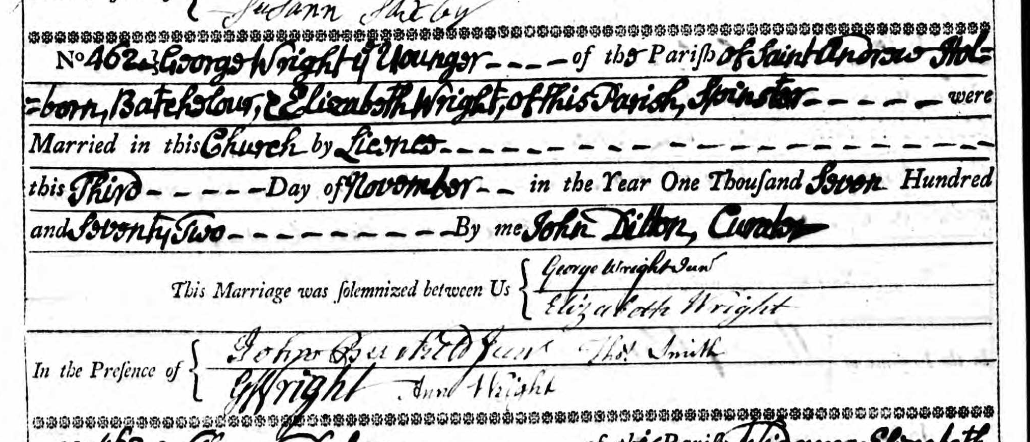 more clearly as an Elizabeth Wright of the parish of Saint Andrew, Holborn.
more clearly as an Elizabeth Wright of the parish of Saint Andrew, Holborn.
That George and Elizabeth shared a last name raises further questions (were they perhaps cousins, close or distant? Or was this mere coincidence?) that remain unanswered. Short himself notes their identical last names in a rather sweet poem of this that I located, appearing as a fugitive piece in the European Magazine and London Review (II [1782]: 16) but that was likely printed previously elsewhere. In this short poem Wright encourages Miss Wright to ‘change but your state and continue your name, Be not Wright only single, but married, the same’ (European Magazine and London Review II [1782]: 16).
Wright’s wife Elizabeth, as Pitcher notes, is listed in the deaths section of the Town and Country (IX [March 1786]: 211). I have also found her death listed in the New London Magazine (8: [1786]: 166), and much more interestingly, in the New Lady’s Magazine (I: [1786]: 112).
The New Lady’s Magazine (1786-1795) was a rival publication to the Lady’s Magazine that was edited by the Rev. Mr. Charles Stanhope. The New Lady’s looked almost identical to the Lady’s Magazine, was published a few doors down from the Robinsons’ magazine, and included a considerable volume of material from the original periodical. The obituary that appears in this magazine provides much more information than was typical. It states: ‘On Sunday, March 5, 1786, died at Peckham, upon a visit to her sister, Mrs. Elizabeth Wright, wife of G. Wright, Esq. of John Street, Tottenham-Court road, a sincere but retired Christian; a dutiful wife, a tender mother, and a real friend, particularly to the poor; her exemplary life and conduct [. . .]’ (I: 112). This, to me, indicates the possibility that George Wright was in some way acquainted with the editors of the new magazine, or had at least exchanged his loyalty from the Lady’s Magazine to its new rival.
The names of Bob Short and George Wright appeared in other periodicals and magazines over the next few years and Wright continued to publish his own books and miscellanies. There is, indeed, much more work to be done in identifying all of his publications and his contributions not only to the Lady’s Magazine but to other periodicals as well. Ultimately I disagree with Pitcher, who believes Wright was, like many others, a ‘semiprofessional compiler [. . .] George Wright belonged to this miscellany of hacks, opportunists, and amateurs, and probably fared as well as most in entertaining and instructing the contemporary reading public’ (Pitcher: 383). His lengthy career and myriad publications require us to consider him as more than a compiler, hack, amateur, or opportunist. In spite of finding nearly everything he wrote infuriating, it seems clear to me that Wright was an author, and that his literary career provoked his fellow periodical contributors into debates and dialogues that remain fascinating and provocative to this day.
Jenny DiPlacidi
School of English
University of Kent
[1] Edward W. Pitcher, ‘The Periodical and Miscellaneous Publications of George Wright (“Bob Short, Junior”)’, Bibliographical Notes 74:4 (1980): 379-408.

